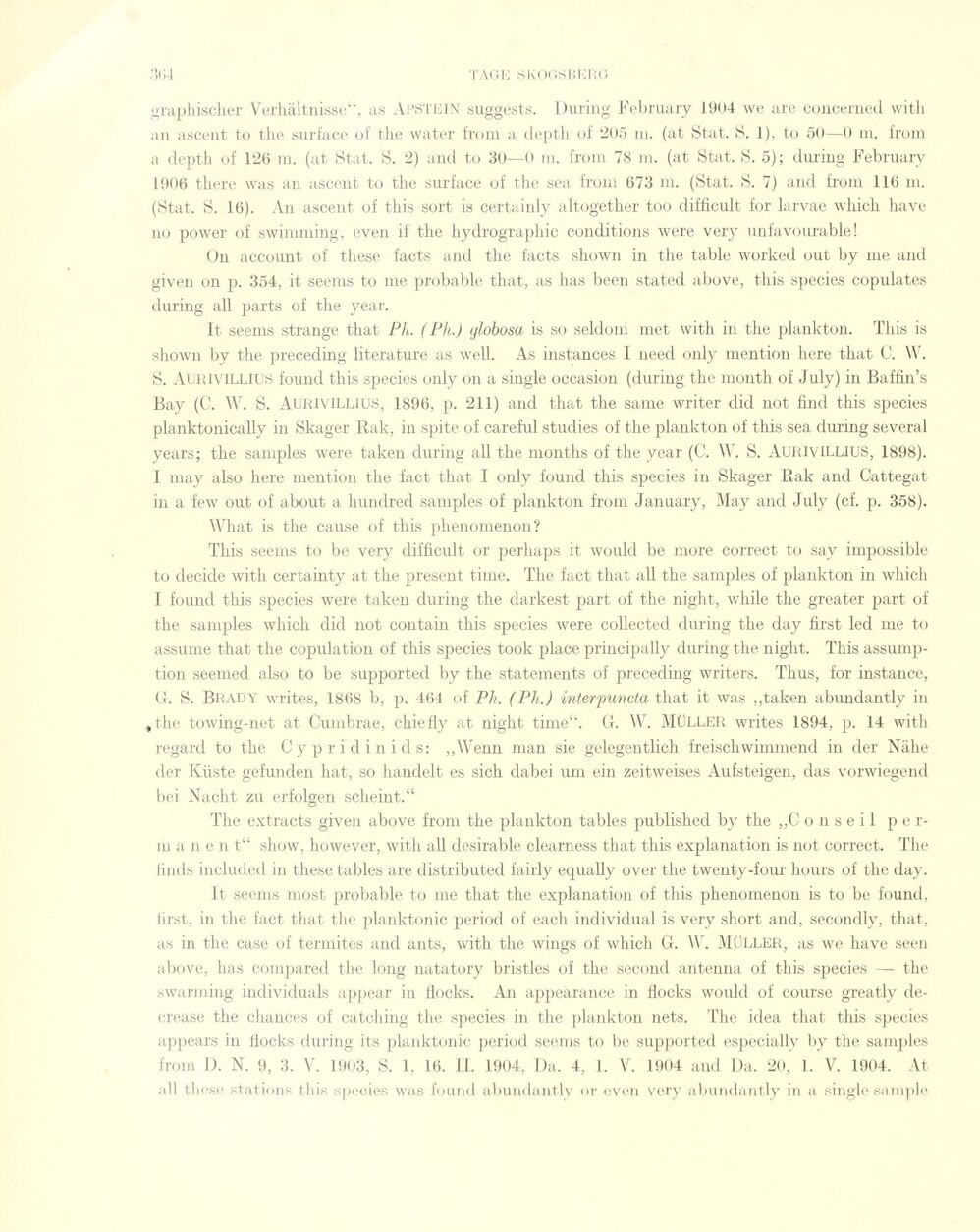
Full resolution (JPEG) - On this page / på denna sida - Sidor ...

<< prev. page << föreg. sida << >> nästa sida >> next page >>
Below is the raw OCR text
from the above scanned image.
Do you see an error? Proofread the page now!
Här nedan syns maskintolkade texten från faksimilbilden ovan.
Ser du något fel? Korrekturläs sidan nu!
This page has never been proofread. / Denna sida har aldrig korrekturlästs.
graphischer Verhältnisse“, as Abstein suggests. During February 1904 we are concerned with
an ascent to the surface of the water from a depth of 205 m. (at Stat. S. 1), to 50—0 m. from
a depth of 126 m. (at Stat. S. 2) and to 30—0 in. from 78 m. (at Stat. S. 5); during February
1906 there was an ascent to the surface of the sea from 673 m. (Stat. S. 7) and from 116 m.
(Stat. S. 16). An ascent of this sort is certainly altogether too difficult for larvae which have
no power of swimming, even if the hydrographie conditions were very unfavourable !
Un account of these facts and the facts shown in the table worked out by me and
given on p. 354, it seems to me probable that, as has beeil stated above, this species copulates
during all parts of the year.
It seems strange that Ph. (Ph.) ylobosa is so seldom met with in the plankton. This is
shown by the preceding literature as well. As instances I need only mention here that C. \V.
S. AURIVILLIUS found this species only on a single occasion (during the month of July) in Baffin’s
Bay (C. W. S. AURIVILLIUS, 1896, p. 211) and that the same writer did not find this species
planktonically in Skager Rak, in spite of careful studies of the plankton of this sea during several
years; the samples were taken during all the months of the year (C. W. S. AURIVILLIUS, 1898).
I may also here mention the faet that I only found this species in Skager Rak and Cattegat
in a few out of about a hundred samples of plankton from January, May and July (cf. p. 358).
What is the cause of this phenomenon?
This seems to be very difficult or perhaps it would be more correct to sav impossible
to decide with certainty at the present time. The faet that all the samples of plankton in which
I found this species were taken during the darkest part of the night, while the greater part of
the samples which did not contain this species were collected during the day first led me to
assume that the copulation of this species took place principally during the night. This
assump-tion seemed also to be supported by the statements of preceding writers. Thus, for instance,
G. S. Brady writes, 1868 b, p. 464 of Ph. (Ph.) interpuncta that it was „taken abundantly in
, the towing-net at Cumbrae, chiefly at night time“. G. W. MÜLLER writes 1894, p. 14 with
regard to the Cypridinids: „Wenn man sie gelegentlich freischwimmend in der Nähe
der Küste gefunden hat, so handelt es sich dabei um ein zeitweises Aufsteigen, das vorwiegend
bei Nacht zu erfolgen scheint.“
The extracts given above from the plankton tables published by the „Conseil
per-m a n e n t“ show, however, with all desirable clearness that this explana tion is not correct. The
finds included in these tables are distributed fairly equally over the twenty-four hours of the day.
It seems most probable to me that the explanation of this phenomenon is to be found,
first, in the fact that the planktonic period of each individual is very short and, secondly, that,
as in the case of termites and ants, with the wings of which G. W. MÜLLER, as we have seen
above, has compared the long natatory bristles of the second antenna of this species — the
swarming individuals appear in flocks. An appearance in flocks would of course greatly
de-crease the chances of catching the species in the plankton nets. The idea that this species
appears in flocks during its planktonic period seems to be supported especially by the samples
from J). N. 9, 3. V. 1903, S. I, 16. II. 1904, Da. 4, 1. V. 1904 and Da. 20, 1. V. 1904. At
all these stations this species was found abundantly or even very abundantly in a single sample
<< prev. page << föreg. sida << >> nästa sida >> next page >>